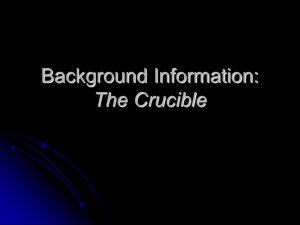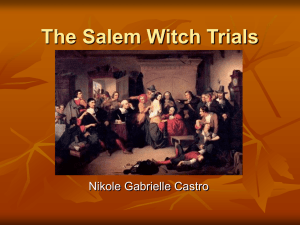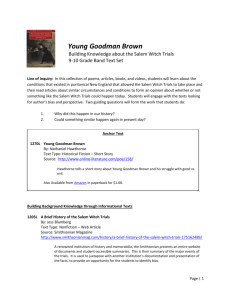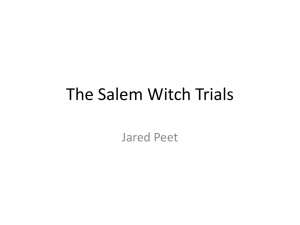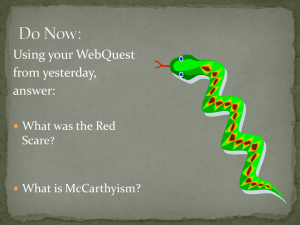Salem Witchcraft Hysteria - nhvweb.net• Students will understand
advertisement
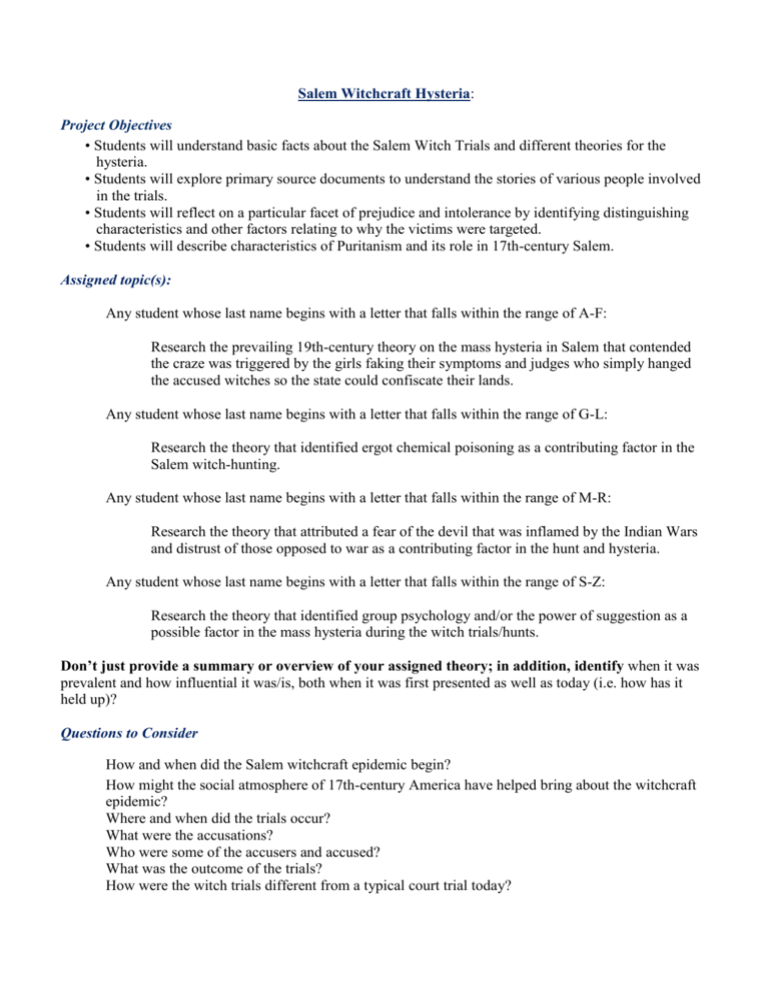
Salem Witchcraft Hysteria: Project Objectives • Students will understand basic facts about the Salem Witch Trials and different theories for the hysteria. • Students will explore primary source documents to understand the stories of various people involved in the trials. • Students will reflect on a particular facet of prejudice and intolerance by identifying distinguishing characteristics and other factors relating to why the victims were targeted. • Students will describe characteristics of Puritanism and its role in 17th-century Salem. Assigned topic(s): Any student whose last name begins with a letter that falls within the range of A-F: Research the prevailing 19th-century theory on the mass hysteria in Salem that contended the craze was triggered by the girls faking their symptoms and judges who simply hanged the accused witches so the state could confiscate their lands. Any student whose last name begins with a letter that falls within the range of G-L: Research the theory that identified ergot chemical poisoning as a contributing factor in the Salem witch-hunting. Any student whose last name begins with a letter that falls within the range of M-R: Research the theory that attributed a fear of the devil that was inflamed by the Indian Wars and distrust of those opposed to war as a contributing factor in the hunt and hysteria. Any student whose last name begins with a letter that falls within the range of S-Z: Research the theory that identified group psychology and/or the power of suggestion as a possible factor in the mass hysteria during the witch trials/hunts. Don’t just provide a summary or overview of your assigned theory; in addition, identify when it was prevalent and how influential it was/is, both when it was first presented as well as today (i.e. how has it held up)? Questions to Consider How and when did the Salem witchcraft epidemic begin? How might the social atmosphere of 17th-century America have helped bring about the witchcraft epidemic? Where and when did the trials occur? What were the accusations? Who were some of the accusers and accused? What was the outcome of the trials? How were the witch trials different from a typical court trial today? What triggered the mass hysteria? How could an entire town believe the evidence? Materials • Streaming videos relating to the Salem Witchcraft trials/hunt: “Salem Witchcraft trials: The Story of the Witch Hunt”: http://www.youtube.com/watch?v=qbFDBrOlE9k Assignment Discovery: “Salem Witch Trials”: http://dsc.discovery.com/tv-shows/other-shows/videos/assignment-discovery-shorts-salemwitch-trials.htm • Article: “Visible and Invisible Worlds of Salem” (posted on the Honors United States History II website) • The American Pageant textbook • NHHS Media Center Pathfinder folder • NHHS Media Center reference cart (located in the Media Center) Procedures Students will work individually and explore/examine one of the theories or explanations presented by past or present experts as well as the descriptions provided by the people who actually experienced the event as eyewitnesses or participants surrounding the Salem witch hunts and trials and to create a visual display summarizing their findings. The display should include visuals that can range from maps, chronologies, portraits, event depictions, charts, quotes/excerpts from either primary or secondary source documents, etc. Depictions should contain captions and explanations and should be relevant/pertinent to the subject or topic being displayed. For instance, portraits of individuals involved or who experienced the event(s) as eyewitnesses/participants might include: A description of the person’s role in the witch trials An analysis of the impetuses or motivations behind his or her actions/behavior A summary of the individuals’ unique point of view or perspective (e.g. as an accuser, an accused, etc.) and the bias associated or related to the individuals’ perspective (e.g. a supporter or a critic of the trials) Displays will be scored on the basis of neatness, organization, and content (see rubric below) A works cited should be included on the back of the display and should be in proper MLA format. Assessment the following three-point rubric will be used to evaluate student work: • 3 points: The student produced a completely thorough and accurate display that presented a significant amount of relevant/pertinent facts surrounding both the trials that took place as well as their assigned theory and/or explanation. A wide variety of relevant/pertinent visuals were used that included captions that fully identified and explained what was being displayed. The layout of the display was both neat and well-organized and all the essential or necessary content was included. A complete works cited was provided in the proper format. Very original presentation of material; Fully captures audience’s attention; Abundance of material clearly related to assigned topic; Points are clearly made and all evidence supports main point(s) being presented; All evidence and examples are appropriate and clearly developed; Material flows together well; All information is succinct and well organized; Display is balanced, varied and appropriate • 2 points: Students shared some facts about the Salem Witch Trials and possible theories for the hysteria; gave a generally accurate and complete presentation about their assigned primary source as well as an acceptable account that reflected on both the event as well as the assigned theory or explanation of the event; Some originality in presentation of material; Satisfactorily captures audience’s attention; Sufficient information is provided; A sufficient amount of important points are made and evidence generally supports main point(s) being presented; Evidence and examples are generally appropriate and clearly developed; Display is unevenly balanced; better flow needed or required; Generally well organized; Some variety • 1 point: Students provided little if any information about the events or the assigned explanation of the events that occurred in Salem; gave an incomplete picture/presentation about their assigned topic; wrote a vague or inaccurate account that did not clearly reflect the assigned theory/explanation; Insufficient amount of information provided; Concepts and ideas are loosely connected; Display was unbalanced; Little to no variation of material presented; little originality and/or interpretation of facts; lacks logical organization and flow; information presented not clearly connected to assigned topic/subject; insufficient/ineffective use of material


